A Holistic Review of Surface Texturing in Sheet Metal Forming: From Sheet Rolling to Final Forming
Abstract
1. Introduction
2. Surface Texturing of Work Rolls for Skin-Pass Cold Rolling
2.1. Work Roll Texturing Methods
2.2. New Methods for Work Roll Texturing
2.3. Comparative Summary Between the New Methods for Work Roll Texturing
2.4. Industrial Practices and Recommendations
3. Texture Transfer from the Roll to the Rolled Sheet
3.1. Contact Conditions on Skin-Pass Cold Rolling
3.2. Influence of the Rolling Conditions
3.3. Influence of the Roll Wear
4. Textured Surfaces and Sheet Formability
4.1. Lubricant Escape Mechanism: MPHSL and MPHDL
4.2. Influence of the Surface Texturing Method on the Sheet Drawability
4.3. Texturing the Sheet or the Die? Insights for Industrial Practices
5. Surface Texturing and Sustainability
- (i)
- (ii)
6. Concluding Remarks
Author Contributions
Funding
Data Availability Statement
Conflicts of Interest
References
- Labiapari, W.d.S.; de Alcântara, C.M.; Costa, H.L.; De Mello, J.D.B. Wear debris generation during cold rolling of stainless steels. J. Mater. Process. Technol. 2015, 223, 164–170. [Google Scholar] [CrossRef]
- Hilgenberg, K.; Steinhoff, K. Texturing of skin-pass rolls by pulsed laser dispersing. J. Mater. Process. Technol. 2015, 225, 84–92. [Google Scholar] [CrossRef]
- Ogarkov, N.; Zvyagina, E.Y.; Ismagilov, R. Theoretical Analysis of Formation of Automobile Sheet Roughness During Temper Rolling in Shot-Blasted Rolls. Steel Transl. 2019, 49, 499–503. [Google Scholar] [CrossRef]
- Simao, J.; Apinwall, D.; Wise, M.; Subari, K. Surface texture transfer in simulated tandem and temper mill rolling using electrical discharge textured rolls. J. Mater. Process. Technol. 1996, 56, 177–189. [Google Scholar] [CrossRef]
- Kijima, H.; Bay, N. Modelling of skinpass rolling by elasto-plastic analysis of plane strain upsetting. J. Mater. Process. Technol. 2006, 177, 509–512. [Google Scholar] [CrossRef]
- Tang, J. Effects of surface roughness microtopography on formability in cold rolled steel sheet. Adv. Mater. Res. 2013, 690–693, 2232–2235. [Google Scholar] [CrossRef]
- Monteiro, P.L.; Labiapari, W.S.; Da Silva, W.M.; Costa, H.L. Durability of deterministic textures produced by maskless electrochemical texturing (MECT) during Skin pass cold rolling. Wear 2025, 562–563, 205638. [Google Scholar] [CrossRef]
- Ould, C.; Badiche, X.; Montmitonnet, P.; Gachon, Y. PVD coatings for mill rolls for cold rolling of high carbon steel strips—Laboratory tests. Wear 2013, 306, 103–112. [Google Scholar] [CrossRef]
- Simão, J.; Aspinwall, D. Hard chromium plating of EDT mill work rolls. J. Mater. Process. Technol. 1999, 92–93, 281–287. [Google Scholar] [CrossRef]
- Gonçalves, J., Jr.; De Mello, J.; Costa, H. Tribological behaviour of alternative surface modifications for cold rolling mill rolls. Wear 2021, 470–471, 203614. [Google Scholar] [CrossRef]
- Wentink, D.; Matthews, D.; Appelman, N.; Toose, E. A generic model for surface texture development, wear and roughness transfer in skin pass rolling. Wear 2015, 328–329, 167–176. [Google Scholar] [CrossRef]
- Wu, C.; Zhang, L.; Qu, P.; Li, S.; Jiang, Z. A new method for predicting the three-dimensional surface texture transfer in the skin pass rolling of metal strips. Wear 2019, 426–427, 1246–1264. [Google Scholar] [CrossRef]
- Belov, V.; Begletsov, D.; D’yakova, M.; Gorbunov, A. Production of sheet with regulated surface microtopography. Steel Transl. 2014, 44, 298–305. [Google Scholar] [CrossRef]
- Pawelski, O.; Rasp, W.; Zwick, W.; Nettelbeck, H.-J.; Steinhoff, K. The influence of different work-roll texturing systems on the development of surface structure in the temper rolling process of steel sheet used in the automotive industry. J. Mater. Process. Technol. 1994, 45, 215–222. [Google Scholar] [CrossRef]
- Benati, F. Effect of Surface Topography upon the Quality of Autobody Panels. Ph.D. Thesis, Brunel University, London, UK, 2003. [Google Scholar]
- Köhler, K.; Kwiaton, N.; Bretschneider, M. Skin Pass Rolling of High Manganese Steels. Mater. Sci. Forum 2016, 854, 93–98. [Google Scholar] [CrossRef]
- Evin, E.; Tomáš, M.; Kmec, J. Optimization of Electro-Discharge Texturing Parameters for Steel Sheets’ Finishing Rollers. Materials 2020, 13, 1223. [Google Scholar] [CrossRef]
- Gorbunov, A.; Belov, V.; Begletsov, D. Texturing of rollers for the production of auto-industry sheet. Steel Transl. 2009, 39, 696–699. [Google Scholar] [CrossRef]
- De Mello, J.D.B.; Gonçalves, J.L., Jr.; Costa, H.L. Influence of surface texturing and hard chromium coating on the wear of steels used in cold rolling mill rolls. Wear 2013, 302, 1295–1309. [Google Scholar] [CrossRef]
- Aspinwall, D.; Wise, M.; Stout, K.; Goh, T.; Zhao, F.; El-Menshawy, M. Electrical discharge texturing. Int. J. Mach. Tools Manuf. 1992, 32, 183–193. [Google Scholar] [CrossRef]
- McGeough, J.; Rasmussen, H. A model for the surface texturing of steel rolls by electrodischarge machining. Proc. R. Soc. Lond. Ser. A Math. Phys. Sci. 1992, 436, 155–164. [Google Scholar]
- Rodriguez-Vidal, E.; Matthews, D.T.A.; de Viteri, V.S.; Korver, F.; Wentink, D.; Quintana, I. Surface design and texturing of strip steel using nanosecond pulsed lasers for simulated roughness transfer and paint appearance. J. Mater. Process. Technol. 2020, 275, 116365. [Google Scholar] [CrossRef]
- Elkoca, O. A study on the characteristics of electrical discharge textured skin pass mill work roll. Surf. Coat. Technol. 2008, 202, 2765–2774. [Google Scholar] [CrossRef]
- De Mare, C.; Scheers, J.; Lambert, F.; Vermeulen, M.; De Graef, L.; Gadeyne, Y. Development of the SIBETEX sheet having excellent drawability and paint appearance. Rev. Métall. 1997, 94, 827–836. [Google Scholar] [CrossRef]
- Costa, H.L.; Profito, F.J.; Zhang, X.; Thole, K.A. Optimizing the surface of manufactured components for friction, adhesion, and convective heat transfer. MRS Bull. 2022, 47, 1247–1259. [Google Scholar] [CrossRef]
- Yuan, S.; Lin, N.; Zou, J.; Liu, Z.; Wang, Z.; Tian, L.; Qin, L.; Zhang, H.; Wang, Z.; Tang, B.; et al. Effect of laser surface texturing (LST) on tribological behavior of double glow plasma surface zirconizing coating on Ti6Al4V alloy. Surf. Coat. Technol. 2019, 368, 97–109. [Google Scholar] [CrossRef]
- Costa, H.; Hutchings, I.M. Some innovative surface texturing techniques for tribological purposes. Proc. Inst. Mech. Eng. Part J J. Eng. Tribol. 2015, 229, 429–448. [Google Scholar] [CrossRef]
- Simao, J.; Aspinwall, D.; Wise, M.; El-Menshawy, M. Mill roll texturing using EDT. J. Mater. Process. Technol. 1994, 45, 207–214. [Google Scholar] [CrossRef]
- Bünten, R.; Steinhoff, K.; Rasp, W.; Kopp, R.; Pawelski, O. Development of a FEM-model for the simulation of the transfer of surface structure in cold-rolling processes. J. Mater. Process. Technol. 1996, 60, 369–376. [Google Scholar] [CrossRef]
- Šugár, P.; Šugárová, J.; Frnčík, M. Laser surface texturing of tool steel: Textured surfaces quality evaluation. Open Eng. 2016, 6, 90–97. [Google Scholar] [CrossRef]
- Kainz, A.; Paesold, D.; Riha, G.; Keintzel, G.; Krimpelstätter, K.; Zeman, K. Finite Element Simulation of Skin-Pass and Temper Rolling Processes with Special Emphasis on Roughness Transfer. In Proceedings of the NAFEMS World Congress, St. Julians, Malta, 17–20 May 2005; pp. 17–20. [Google Scholar]
- Weidel, S.; Engel, U. Surface characterisation in forming processes by functional 3D parameters. Int. J. Adv. Manuf. Technol. 2007, 33, 130–136. [Google Scholar] [CrossRef]
- Shimizu, I.; Andreasen, J.L.; Bech, J.I.; Bay, N. Influence of workpiece surface topography on the mechanisms of liquid lubrication in strip drawing. J. Trib. 2001, 123, 290–294. [Google Scholar] [CrossRef]
- Ueno, M.; Fujita, N.; Kimura, Y.; Nakata, N. Evaluation of coating and wear characteristics of roll surface coated with TiC by electrical discharge coating. J. Mater. Process. Technol. 2016, 236, 9–15. [Google Scholar] [CrossRef]
- Warneke, P.; Bohlen, A.; Seefeld, T. Texturing skin-pass rolls by high-speed laser melt injection, laser ablation, and electrolytic etching. J. Laser Appl. 2024, 36, 012011. [Google Scholar] [CrossRef]
- Kümmel, D.; Hamann-Schroer, M.; Hetzner, H.; Schneider, J. Tribological behavior of nanosecond-laser surface textured Ti6Al4V. Wear 2019, 422–423, 261–268. [Google Scholar] [CrossRef]
- Zimnik, W.; Ritterbach, B.; Mull, K. Pretex—A new method of producing textured sheets for the highest requirements. Stahl. Eisen. 1998, 118, 75. [Google Scholar]
- Hutchings, I.; Shipway, P. Tribology: Friction and Wear of Engineering Materials; Butterworth-Heinemann: Oxford, UK, 2017. [Google Scholar]
- Ould, C.; Gachon, Y.; Badiche, X.; Montmitonnet, P. Tribological and mechanical laboratory analysis of DLC as substitutes for hard chromium coating in view of cold rolling of high carbon steel strips. Int. J. Adv. Manuf. Technol. 2023, 129, 5435–5446. [Google Scholar] [CrossRef]
- Steinhoff, K. Thermal implantation of metal carbide particles. Proc. 10th ICFC 2000, 2000, 243–259. [Google Scholar]
- Hilgenberg, K.; Behler, K.; Steinhoff, K. Localized dispersing of ceramic particles in tool steel surfaces by pulsed laser radiation. Appl. Surf. Sci. 2014, 305, 575–580. [Google Scholar] [CrossRef]
- Ould, C.; Badiche, X.; Montmitonnet, P.; Gachon, Y. PVD coated mill rolls for cold rolling of stainless steel strips—Tribological and mechanical laboratory tests. J. Manuf. Process. 2013, 15, 77–86. [Google Scholar] [CrossRef]
- Tavares, A.; Lopes, A.; Mesquita, E.; Almeida, D.; Souza, J.; Costa, H. Effect of transfer layers on friction and wear mechanisms in strip drawing tests of commercially coated forming tools. Wear 2021, 476, 203733. [Google Scholar] [CrossRef]
- Gonçalves Júnior, J.L. Avaliação Tribológica de Novas Modificações Superficiais Para Cilindros de Laminação a Frio. Ph.D. Thesis, Universidade Federal de Uberlândia, Uberlândia, Brazil, 2016. [Google Scholar]
- Salicio-Paz, A.; Grande, H.; Pellicer, E.; Sort, J.; Fornell, J.; Offoiach, R.; Lekka, M.; García-Lecina, E. Monolayered versus multilayered electroless NiP coatings: Impact of the plating approach on the microstructure, mechanical and corrosion properties of the coatings. Surf. Coat. Technol. 2019, 368, 138–146. [Google Scholar] [CrossRef]
- Sudagar, J.; Lian, J.; Sha, W. Electroless nickel, alloy, composite and nano coatings—A critical review. J. Alloys Compd. 2013, 571, 183–204. [Google Scholar] [CrossRef]
- Gonçalves, J.L.; De Mello, J.D.B.; Costa, H.L. Wear in cold rolling milling rolls: A methodological approach. Wear 2019, 426–427, 1523–1535. [Google Scholar] [CrossRef]
- Rodrigues, T.; Costa, H.; da Silva, W., Jr. Sliding wear behavior of electrochemically textured surfaces under different lubrication regimes: Effects of curvature radius. Wear 2021, 477, 203817. [Google Scholar] [CrossRef]
- Costa, H.; Hutchings, I. Development of a maskless electrochemical texturing method. J. Mater. Process. Technol. 2009, 209, 3869–3878. [Google Scholar] [CrossRef]
- Dias, L.C.; Ferri, G.G.B.; Costa, H.L. Maskless electrochemical surface texturing for cylindrical components: New developments. J. Braz. Soc. Mech. Sci. Eng. 2024, 46, 297. [Google Scholar] [CrossRef]
- Rodrigues, T.A.; Arencibia, R.V.; Costa, H.L.; da Silva, W.M. Roughness analysis of electrochemically textured surfaces: Effects on friction and wear of lubricated contacts. Surf. Topogr. Metrol. Prop. 2020, 8, 024011. [Google Scholar] [CrossRef]
- Parreira, J.; Gallo, C.; Costa, H. New advances on maskless electrochemical texturing (MECT) for tribological purposes. Surf. Coat. Technol. 2012, 212, 1–13. [Google Scholar] [CrossRef]
- Da Silva, L.; Costa, H. Maskless electrochemical texturing of automotive cylinders. Mater. Perform. Charact. 2017, 6, 96–111. [Google Scholar] [CrossRef]
- Itapu, S.; Borra, V.; Li, F.X.; Cortes, P.; Kumar, M.H. Effect of laser irradiation on the tribological properties of RF-sputtered nickel oxide (NiO) thin films. Vacuum 2022, 205, 111461. [Google Scholar] [CrossRef]
- Daenzer, T. Laser Beam Texturing for Automotive Metal Forming Applications. AM&P Tech. Artic. 2014, 172, 25–27. [Google Scholar]
- Warneke, P.; Bohlen, A.; Seefeld, T. Influence of the process speed in laser melt injection for reinforcing skin-pass rolls. J. Laser Appl. 2023, 35, 012009. [Google Scholar] [CrossRef]
- Spranger, F.; de Oliveira Lopes, M.; Schirdewahn, S.; Degner, J.; Merklein, M.; Hilgenberg, K. Microstructural evolution and geometrical properties of TiB2 metal matrix composite protrusions on hot work tool steel surfaces manufactured by laser implantation. Int. J. Adv. Manuf. Technol. 2020, 106, 481–501. [Google Scholar] [CrossRef]
- Silva, R.S.; Lopes, A.P.O.; Luz, F.K.C.; de Almeida, D.T.; Costa, H.L. Effect of tool microstructure on the tribological behaviour of electrochemically textured tools in strip drawing tests. Wear 2025, 205759. [Google Scholar] [CrossRef]
- Łach, Ł. Recent advances in laser surface hardening: Techniques, modeling approaches, and industrial applications. Crystals 2024, 14, 726. [Google Scholar] [CrossRef]
- Gachot, C.; Rosenkranz, A.; Hsu, S.; Costa, H. A critical assessment of surface texturing for friction and wear improvement. Wear 2017, 372–373, 21–41. [Google Scholar] [CrossRef]
- Rosenkranz, A.; Grützmacher, P.G.; Gachot, C.; Costa, H.L. Surface texturing in machine elements—A critical discussion for rolling and sliding contacts. Adv. Eng. Mater. 2019, 21, 1900194. [Google Scholar] [CrossRef]
- Evin, E.; Kokarda, V.; Tomáš, M. Quality Control of Electro-Discharge Texturing of Rolls Through Six Sigma. Processes 2025, 13, 450. [Google Scholar] [CrossRef]
- Paturi, U.M.R.; Palakurthy, S.T.; Reddy, N. The role of machine learning in tribology: A systematic review. Arch. Comput. Methods Eng. 2023, 30, 1345–1397. [Google Scholar] [CrossRef]
- Shah, R.; Pai, N.; Thomas, G.; Jha, S.; Mittal, V.; Shirvni, K.; Liang, H. Machine learning in wear prediction. J. Tribol. 2025, 147, 040801. [Google Scholar] [CrossRef]
- Steinhoff, K.; Bünten, R.; Rasp, W.; Kopp, R.; Pawelski, O. Development of a model for the simulation of the transfer of surface structure in the temper—Rolling process. Steel Res. 1995, 66, 520–525. [Google Scholar] [CrossRef]
- Wu, C.; Zhang, L. Surface texture transfer in skin-pass rolling under mixed lubrication. Int. J. Mech. Sci. 2025, 286, 109858. [Google Scholar] [CrossRef]
- Sun, J.; Huang, H.; Du, F.; Li, X. Nonlinear Finite Element Analysis of Thin Strip Temper Rolling Process. J. Iron Steel Res. Int. 2009, 16, 27–32. [Google Scholar] [CrossRef]
- Kijima, H.; Bay, N. Contact conditions in skin-pass rolling. CIRP Ann. 2007, 56, 301–306. [Google Scholar] [CrossRef]
- Fleck, N.; Johnson, K. Towards a new theory of cold rolling thin foil. Int. J. Mech. Sci. 1987, 29, 507–524. [Google Scholar] [CrossRef]
- Fleck, N.; Johnson, K.; Mear, M.; Zhang, L. Cold rolling of foil. Proc. Inst. Mech. Eng. Part B J. Eng. Manuf. 1992, 206, 119–131. [Google Scholar] [CrossRef]
- Yuen, W.; Dixon, A.; Nguyen, D. The modelling of the mechanics of deformation in flat rolling. J. Mater. Process. Technol. 1996, 60, 87–94. [Google Scholar] [CrossRef]
- Wu, C.; Zhang, L.; Qu, P.; Li, S.; Jiang, Z. Effect of the elastic deformation of rolls on the surface texture transfer in skin-pass rolling. Int. J. Mech. Sci. 2021, 198, 106358. [Google Scholar] [CrossRef]
- Kijima, H. Mechanism of Roughness Profile Transfer in Skin-Pass Rolling of Thin Steel Strip; JFE Technical Report; JFE Steel Corporation: Tokyo, Japan, 2019; pp. 129–134. [Google Scholar]
- Çolak, B.; Kurgan, N. An experimental investigation into roughness transfer in skin-pass rolling of steel strips. Int. J. Adv. Manuf. Technol. 2018, 96, 3321–3330. [Google Scholar] [CrossRef]
- Kijima, H. An experimental investigation on the influence of lubrication on roughness transfer in skin-pass rolling of steel strip. J. Mater. Process. Technol. 2015, 225, 1–8. [Google Scholar] [CrossRef]
- Wu, C.; Zhang, L.; Qu, P.; Li, S.; Jiang, Z. A simple approach for analysing the surface texture transfer in cold rolling of metal strips. Int. J. Adv. Manuf. Technol. 2018, 95, 597–608. [Google Scholar] [CrossRef]
- Özakın, B.; Çolak, B.; Kurgan, N. Effect of material thickness and reduction ratio on roughness transfer in skin-pass rolling to DC04 grade sheet materials. Ind. Lubr. Tribol. 2021, 73, 676–682. [Google Scholar] [CrossRef]
- Özakın, B.; Kurgan, N. Experimental investigation of roughness transfer with skin-pass rolling to high strength low alloy (HSLA) material. Arab. J. Sci. Eng. 2021, 46, 12137–12144. [Google Scholar] [CrossRef]
- Ma, B.; Tieu, A.; Lu, C.; Jiang, Z. An experimental investigation of steel surface characteristic transfer by cold rolling. J. Mater. Process. Technol. 2002, 125–126, 657–663. [Google Scholar] [CrossRef]
- Burdek, M. The change of work roll surface topography during skin pass rolling of steel sheets. Ind. Lubr. Tribol. 2015, 67, 606–611. [Google Scholar] [CrossRef]
- Wu, C.; Zhang, L.; Qu, P.; Li, S.; Jiang, Z.; Li, W. Surface texture transfer in skin-pass rolling with the effect of roll surface wear. Wear 2021, 476, 203764. [Google Scholar] [CrossRef]
- Zabala, A.; Galdos, L.; Childs, C.; Llavori, I.; Aginagalde, A.; Mendiguren, J.; Saenz de Argandoña, E. The interaction between the sheet/tool surface texture and the friction/galling behaviour on aluminium deep drawing operations. Metals 2021, 11, 979. [Google Scholar] [CrossRef]
- Pfestorf, M.; Engel, U.; Geiger, M. 3D-surface parameters and their application on deterministic textured metal sheets. Int. J. Mach. Tools Manuf. 1998, 38, 607–614. [Google Scholar] [CrossRef]
- Weidel, S.; Engel, U.; Merklein, M.; Geiger, M. Basic investigations on boundary lubrication in metal forming processes by in situ observation of the real contact area. Prod. Eng. 2010, 4, 107–114. [Google Scholar] [CrossRef]
- Dubois, A. Metal Forming and Lubrication. In Reference Module in Materials Science and Materials Engineering; Elsevier: Amsterdam, The Netherlands, 2016. [Google Scholar] [CrossRef]
- Azushima, A.; Kudo, H. Direct observation of contact behaviour to interpret the pressure dependence of the coefficient of friction in sheet metal forming. CIRP Ann. 1995, 44, 209–212. [Google Scholar] [CrossRef]
- Bech, J.; Bay, N.; Eriksen, M. A study of mechanisms of liquid lubrication in metal forming. CIRP Ann. 1998, 47, 221–226. [Google Scholar] [CrossRef]
- Wiklund, D.; Rosén, B.-G.; Gunnarsson, L. Frictional mechanisms in mixed lubricated regime in steel sheet metal forming. Wear 2008, 264, 474–479. [Google Scholar] [CrossRef]
- Vermeulen, M.; Scheers, J. Micro-hydrodynamic effects in EBT textured steel sheet. Int. J. Mach. Tools Manuf. 2001, 41, 1941–1951. [Google Scholar] [CrossRef]
- Burdek, M. Physical modeling of the steel sheet topography in skin pass rolling and its influence on susceptibility of sheets to deep drawing. Steel Res. Int. 2016, 87, 456–464. [Google Scholar] [CrossRef]
- Liu, X.; Liewald, M.; Becker, D. Effects of rolling direction and lubricant on friction in sheet metal forming. J. Tribol. 2009, 131, 042101. [Google Scholar] [CrossRef]
- Coello, J.; Miguel, V.; Martínez, A.; Avellaneda, F.; Calatayud, A. Friction behavior evaluation of an EBT zinc-coated trip 700 steel sheet through flat friction tests. Wear 2013, 305, 129–139. [Google Scholar] [CrossRef]
- Xie, H.; Chen, D.; Kong, X. An analysis of the three-dimensional surface topography of textured cold-rolled steel sheets. Tribol. Int. 1999, 32, 83–87. [Google Scholar] [CrossRef]
- Sacerdotti, F.; Griffiths, B.; Butler, C.; Benati, F. Surface topography in autobody manufacture—The state of the art. Proc. Inst. Mech. Eng. Part B J. Eng. Manuf. 2000, 214, 811–820. [Google Scholar] [CrossRef]
- Abe, Y.; Mori, K.; Hatashita, F.; Shiba, T.; Daodon, W.; Osakada, K. Improvement of seizure resistance in ironing of stainless steel cup with cermet die having fine lubricant pockets. J. Mater. Process. Technol. 2016, 234, 195–207. [Google Scholar] [CrossRef]
- Costa, H.; Hutchings, I. Effects of die surface patterning on lubrication in strip drawing. J. Mater. Process. Technol. 2009, 209, 1175–1180. [Google Scholar] [CrossRef]
- Shrivastava, A.; Kumar, D.R.; Manikandan, G.; Verma, R.K. Laser surface texturing of dies in strip drawing of DP600 steel sheet. Surf. Eng. 2023, 39, 870–881. [Google Scholar] [CrossRef]
- Shimizu, T.; Kobayashi, H.; Vorholt, J.; Yang, M. Lubrication analysis of micro-dimple textured die surface by direct observation of contact interface in sheet metal forming. Metals 2019, 9, 917. [Google Scholar] [CrossRef]
- Hazrati, J.; Stein, P.; Kramer, P.; Van Den Boogaard, A. Tool texturing for deep drawing applications. IOP Conf. Ser. Mater. Sci. Eng. 2018, 418, 012095. [Google Scholar] [CrossRef]
- Sulaiman, M.H.; Christiansen, P.; Bay, N. The influence of tool texture on friction and lubrication in strip reduction testing. Lubricants 2017, 5, 3. [Google Scholar] [CrossRef]
- Flegler, F.; Neuhäuser, S.; Groche, P. Influence of sheet metal texture on the adhesive wear and friction behaviour of EN AW-5083 aluminum under dry and starved lubrication. Tribol. Int. 2020, 141, 105956. [Google Scholar] [CrossRef]
- Woydt, M. The importance of tribology for reducing CO2 emissions and for sustainability. Wear 2021, 474–475, 203768. [Google Scholar] [CrossRef]
- Holmberg, K.; Erdemir, A. Influence of tribology on global energy consumption, costs and emissions. Friction 2017, 5, 263–284. [Google Scholar] [CrossRef]
- Ling, J.; Yang, H.; Tian, G.; Cheng, J.; Wang, X.; Yu, X. Direct reduction of iron to facilitate net zero emissions in the steel industry: A review of research progress at different scales. J. Clean. Prod. 2024, 441, 140933. [Google Scholar] [CrossRef]
- de Mello, J.D.B.; Costa, H.L. Brazilian Tribology: Origin, status quo and future perspectives. Surf. Topogr. Metrol. Prop. 2023, 11, 030201. [Google Scholar] [CrossRef]
- Labiapari, W.S.; Costa, R.J.G.; de Alcântara, C.M.; Pagani, V.; Di Cunto, J.C.; de Mello, J.D. Green Ferritic Stainless Steel: A Sustainable, Advanced and Cost-Effective Solution for the Concrete Mixer Drum. In Proceedings of the I4SDG Workshop 2021: IFToMM for Sustainable Development Goals, Online, 25–26 November 2021; Springer: Cham, Switzerland, 2022; pp. 429–437. [Google Scholar]
- Niekurzak, M.; Kubińska-Jabcoń, E. Assessment of the Impact of Wear of the Working Surface of Rolls on the Reduction of Energy and Environmental Demand for the Production of Flat Products: Methodological Approach. Materials 2022, 15, 2334. [Google Scholar] [CrossRef]
- Çolak, B. A comparison of tonnage-dependent shot blast and electro-discharge texturing methods. Surf. Topogr. Metrol. Prop. 2021, 9, 035051. [Google Scholar] [CrossRef]
- Menezes, P.L. Surface texturing to control friction and wear for energy efficiency and sustainability. Int. J. Adv. Manuf. Technol. 2016, 85, 1385–1394. [Google Scholar] [CrossRef]
- Więckowski, W.; Adamus, J.; Dyner, M. Sheet metal forming using environmentally benign lubricant. Arch. Civ. Mech. Eng. 2020, 20, 1–12. [Google Scholar] [CrossRef]
- Lee, P.; Carpick, R. Tribology Opportunities for Enhancing America’s Energy Efficiency—A Report to the Advanced Research Projects Agency; Society of Tribologists and Lubrication Engineers: Park Ridge, IL, USA, 2017. [Google Scholar]
- Jost, H.P. Tribology—Origin and future. Wear 1990, 136, 1–17. [Google Scholar] [CrossRef]
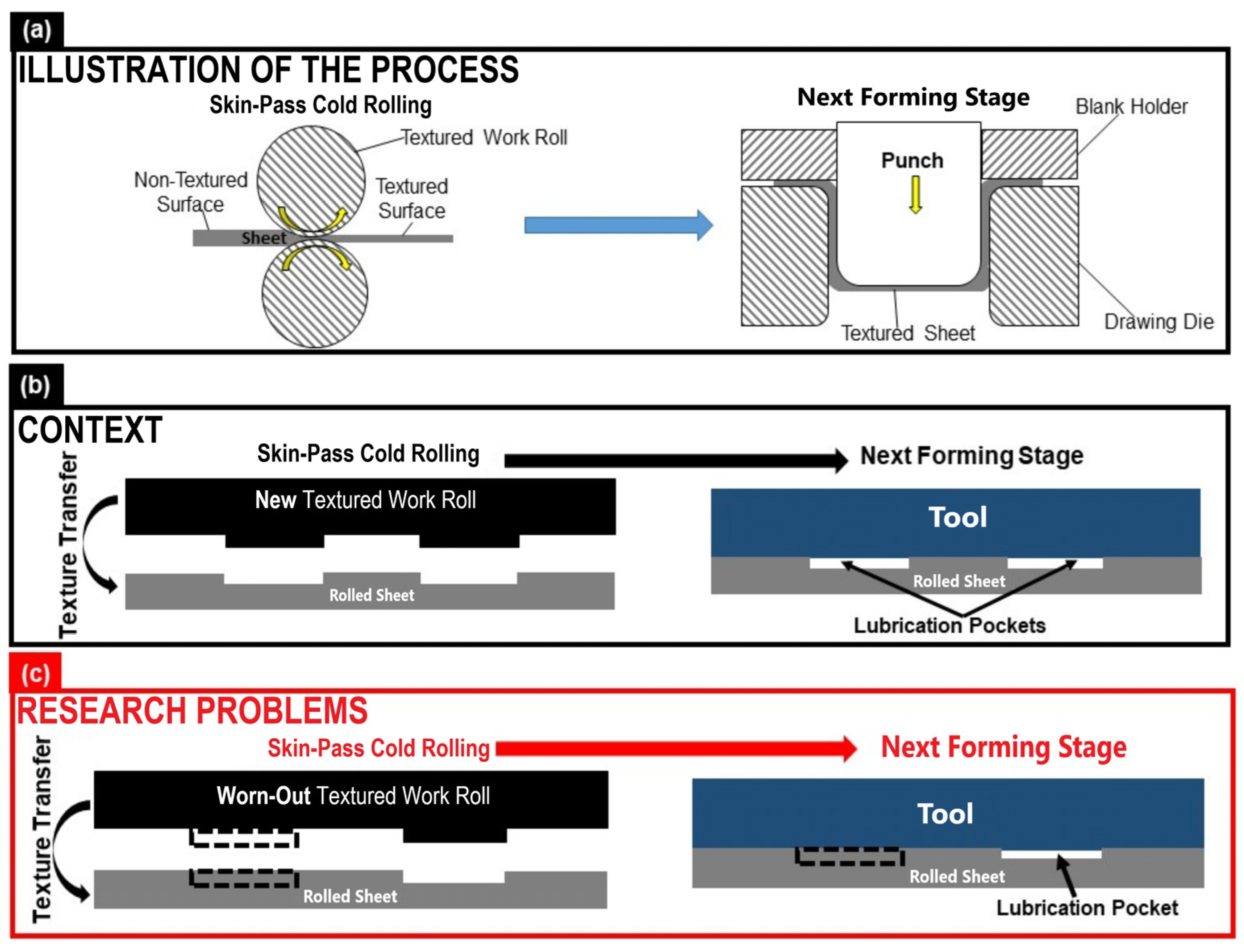
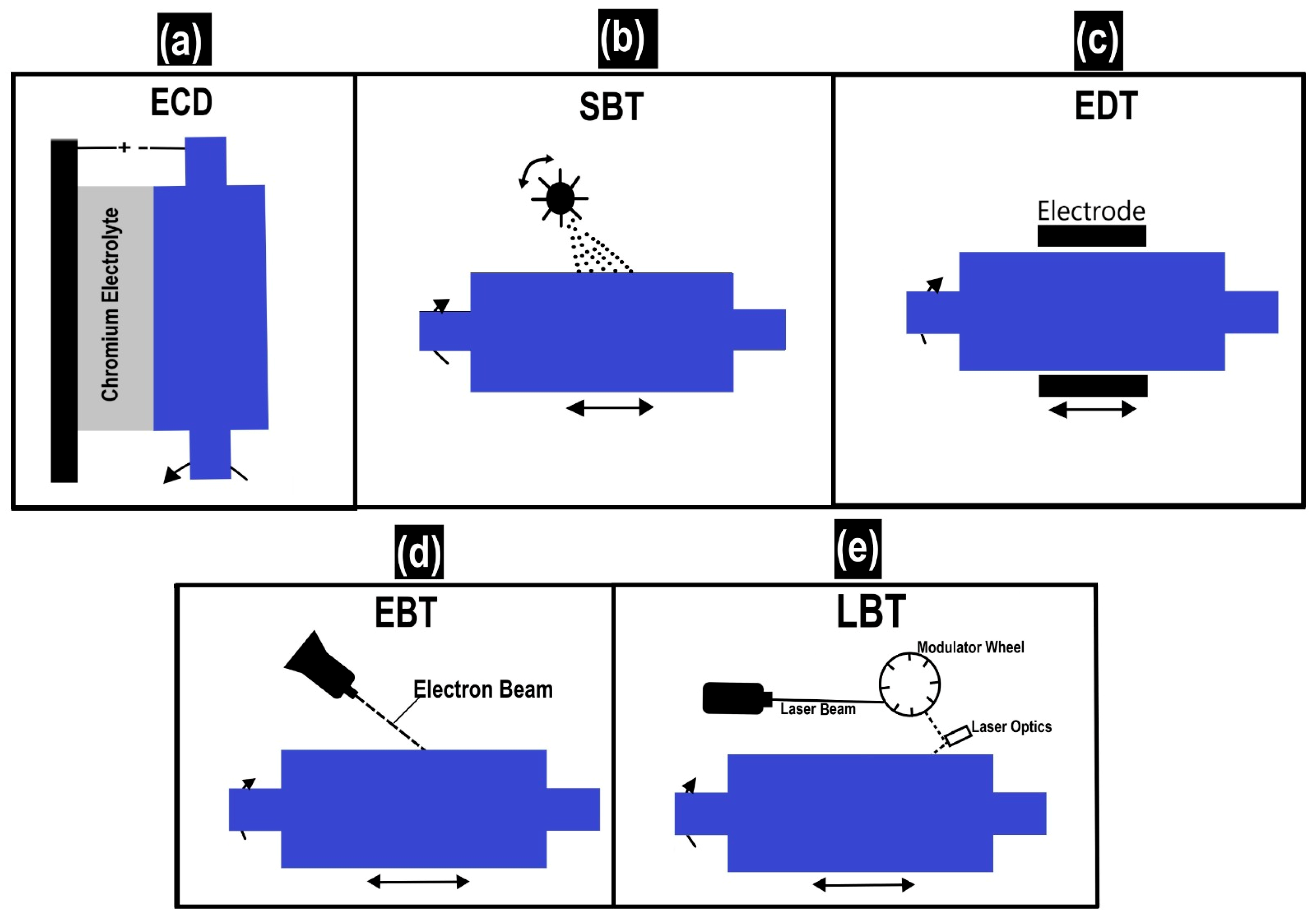

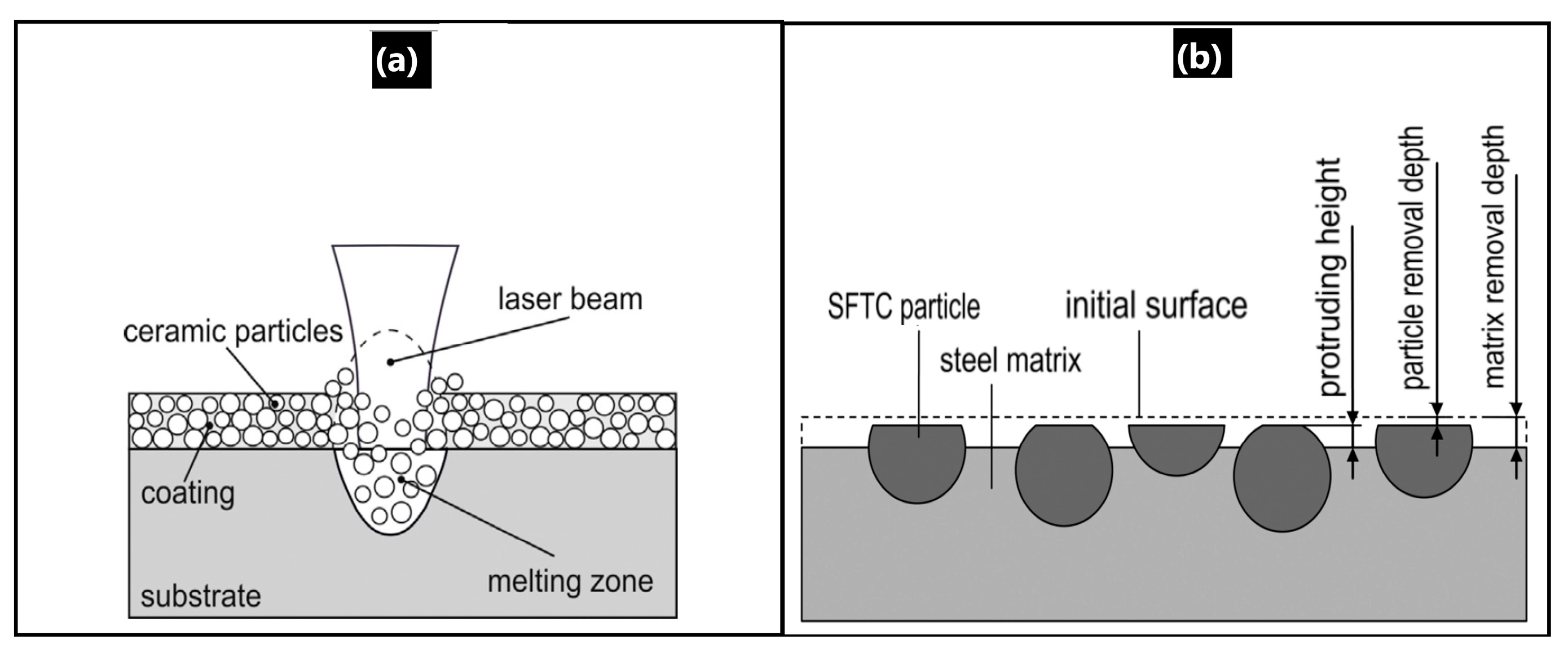

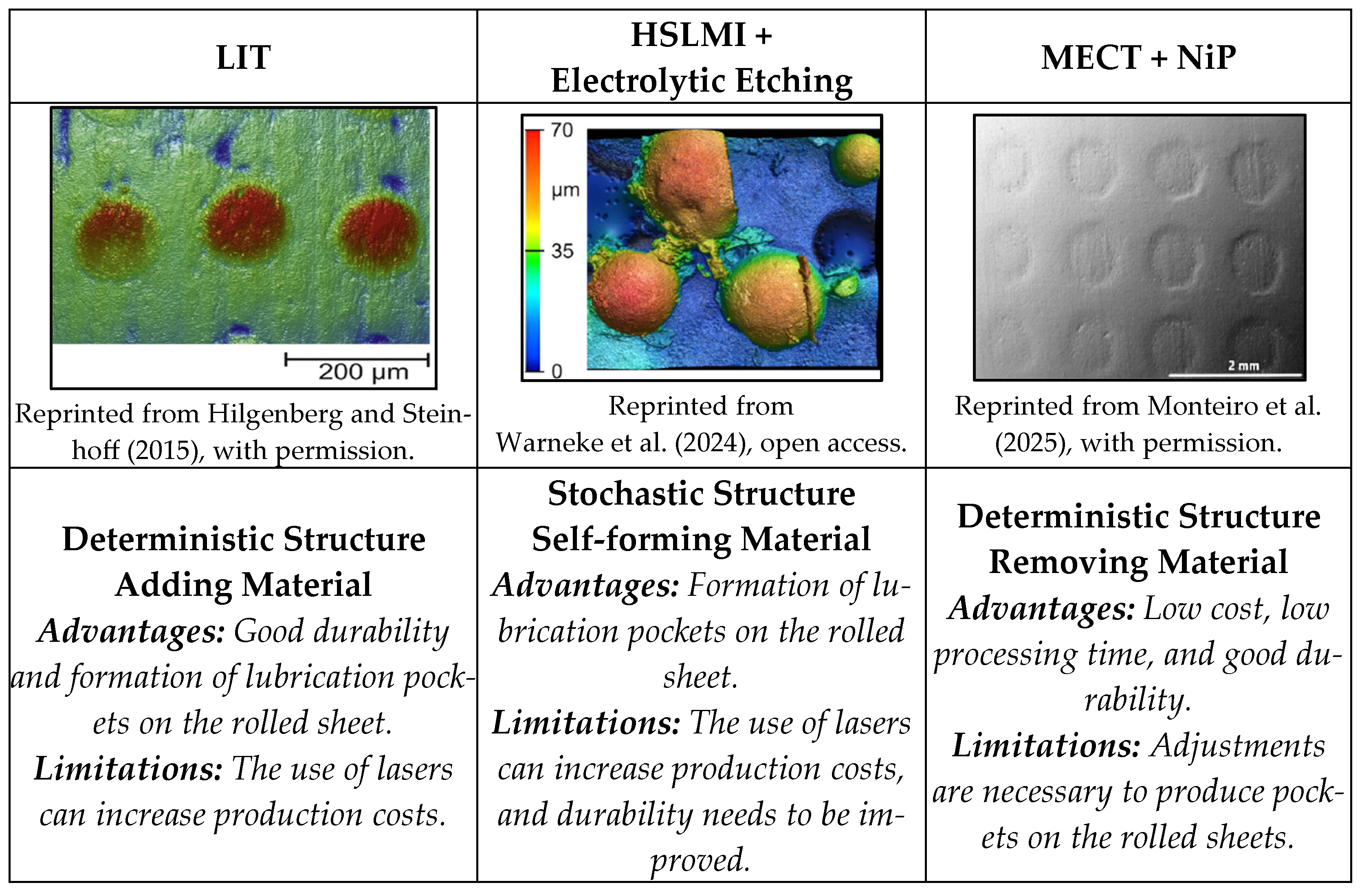

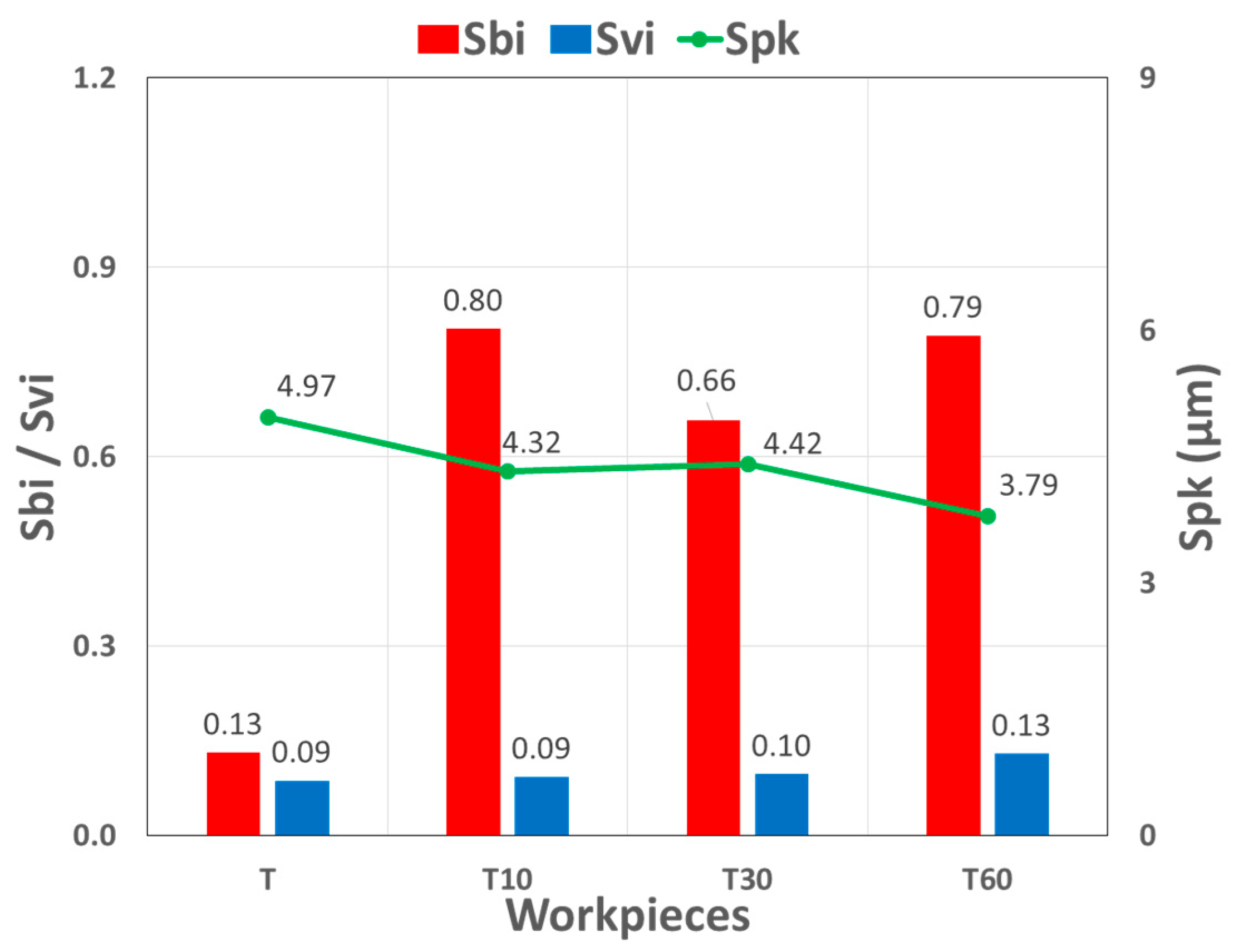
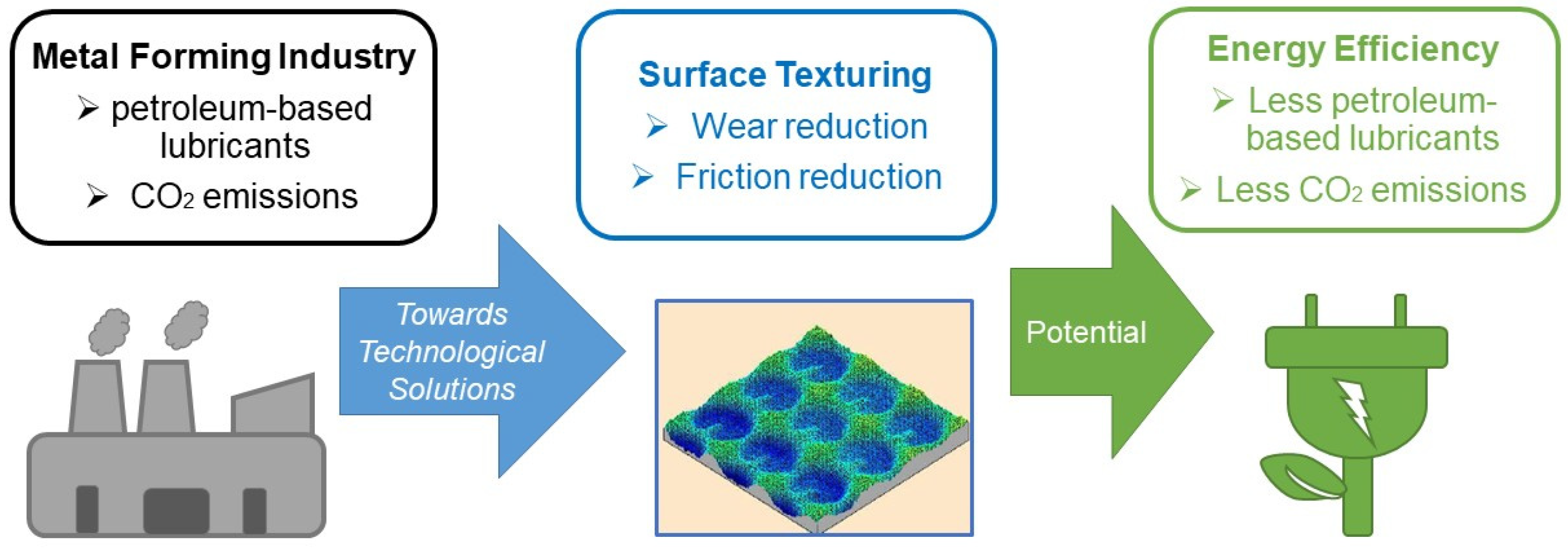
| Rolling Conditions | Effect on Roughness Transfer | References |
|---|---|---|
| Reduction ratio | As the reduction ratio increases, the roughness transfer ratio increases. | [4,12,14,51,76,78,79] |
| Rolling speed | The increase in rolling speed does not significantly affect the roughness transfer ratio. | [12,78] |
| The increase in rolling speed increases the roughness transfer ratio. | [74,79] | |
| Lubricating condition | Roughness transfer ratio decreases under the conditions where the lubricant is used. | [14,73,74,78] |
| Criterion | Sheet Texturing via Skin-Pass Rolling | Die Texturing |
|---|---|---|
| Durability of Textures | The textures on the sheet can be deformed or removed during the initial forming stages. This effect is more critical in multi-stage forming processes [99,100]. | The durability of textures on dies remains an open question. Repetitive contact with the sheet can lead to rapid degradation of the textures. To mitigate this effect, coatings can be applied [58,101]. |
| Control over Texture Geometry | Reproducing textured surfaces on a large scale is challenging due to the wear of the rolling mill roll. Additionally, the texture may need to meet aesthetic requirements, which can limit its optimization for forming [7,100]. | Die texturing allows adjustments according to the needs of the stamping process. This level of customization is crucial for optimizing lubrication and minimizing wear [97,98]. |
Disclaimer/Publisher’s Note: The statements, opinions and data contained in all publications are solely those of the individual author(s) and contributor(s) and not of MDPI and/or the editor(s). MDPI and/or the editor(s) disclaim responsibility for any injury to people or property resulting from any ideas, methods, instructions or products referred to in the content. |
© 2025 by the authors. Licensee MDPI, Basel, Switzerland. This article is an open access article distributed under the terms and conditions of the Creative Commons Attribution (CC BY) license (https://creativecommons.org/licenses/by/4.0/).
Share and Cite
Monteiro, P.L., Jr.; Costa, H.L. A Holistic Review of Surface Texturing in Sheet Metal Forming: From Sheet Rolling to Final Forming. Lubricants 2025, 13, 253. https://doi.org/10.3390/lubricants13060253
Monteiro PL Jr., Costa HL. A Holistic Review of Surface Texturing in Sheet Metal Forming: From Sheet Rolling to Final Forming. Lubricants. 2025; 13(6):253. https://doi.org/10.3390/lubricants13060253
Chicago/Turabian StyleMonteiro, Paulo L., Jr., and Henara L. Costa. 2025. "A Holistic Review of Surface Texturing in Sheet Metal Forming: From Sheet Rolling to Final Forming" Lubricants 13, no. 6: 253. https://doi.org/10.3390/lubricants13060253
APA StyleMonteiro, P. L., Jr., & Costa, H. L. (2025). A Holistic Review of Surface Texturing in Sheet Metal Forming: From Sheet Rolling to Final Forming. Lubricants, 13(6), 253. https://doi.org/10.3390/lubricants13060253






